11 stunning UNESCO sites in the Czech Republic outside of Prague
Most people who visit Czechia focus on Prague. Prague is such a beautiful city that it makes a great city trip for a weekend or a week, and no wonder: the old city of Prague is the most important of the UNESCO sites in the Czech Republic. Prague’s Jewish Quarter is a part of the old city that I’ve written about before.
(Disclosure: This article contains affiliate links. If you make a purchase through one of these links, I will receive a small percentage. It will not affect your price.)
However, the Czech Republic has 11 more UNESCO sites, and I’ve managed to visit many of them, all well worth leaving Prague for! For the ones I haven’t visited, two of my fellow bloggers have pitched in to complete the list. The map below shows where each of them is:
Below I (and two fellow bloggers) describe each of the sites, in more or less alphabetical order. For some of them, separate articles provide more information, so I’ve added links for you to read more if you want. At the end of this article I’ve included information for visiting each: hours, prices, etc.
Český Krumlov
Český Krumlov is a UNESCO-listed site because of its intact medieval center, where the houses are clustered along a meander in the Vitava River, surrounding an imposing castle on a hill.

It’s absolutely charming to spend a day or two exploring the cobbled streets of Český Krumlov. The views from the castle are stunning. You can read my article about it here: Visiting Cesky Krumlov Castle and UNESCO site.
Holašovice historic village
This UNESCO site, not far from Český Krumlov, is a bit odd compared to the others because, well, there’s not much to it.
Holašovice, according to UNESCO, is “an exceptionally complete and well-preserved example of a traditional central European village” and contains “outstanding 18th- and 19th-century vernacular buildings in a style known as ‘South Bohemian folk Baroque’.”
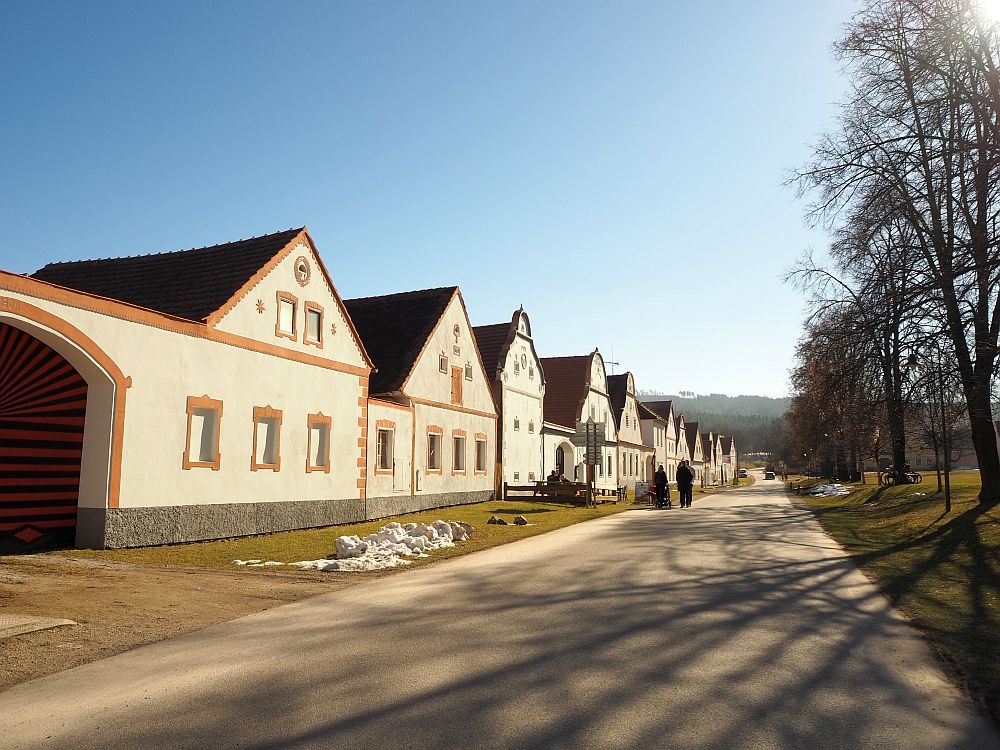
What we found when we got there was two long rows of these folk houses: farmhouses, essentially. The two rows face each other over a long, rectangular town green. The houses are, indeed, interesting, but only take a few minutes to see. One has a museum, but, although it looked open, no one was there to let us in, so we never saw the inside. Otherwise, the houses seem to be residences: not set up for tourism.
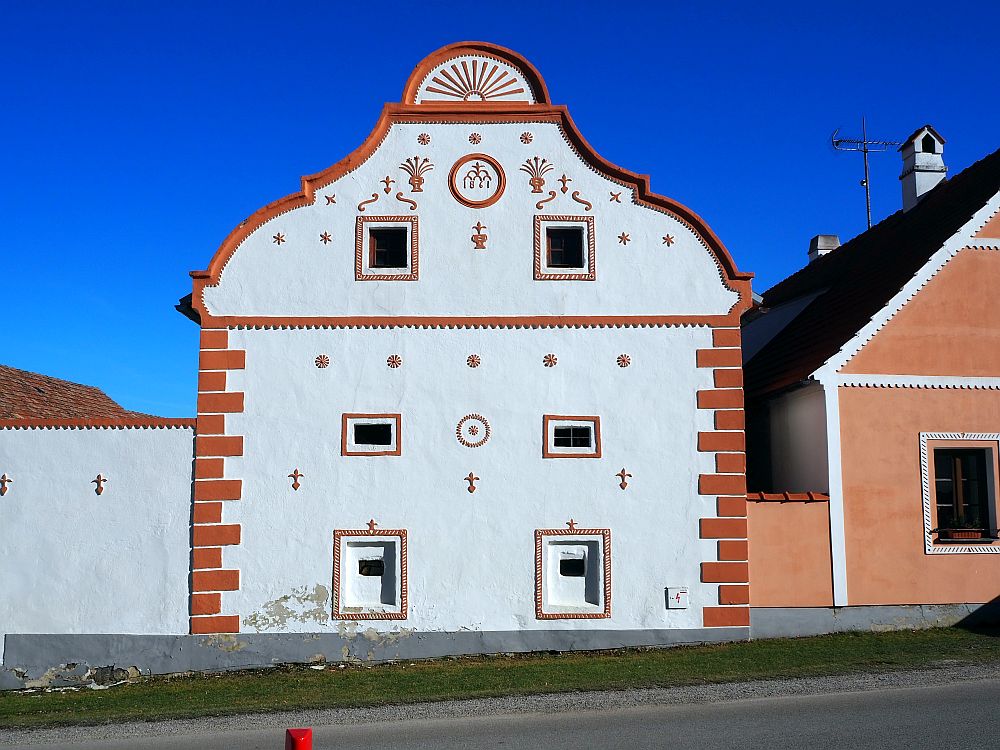
We did stop at one of them which had a makeshift restaurant: a few tables outside where people sat drinking beer in the weak February sun. Being presented with only two choices – some sort of sandwich and some sort of soup – I chose the sandwich and my husband chose the soup. The sandwich turned out to be what I think was pork fat, garnished with pickle and onion. It was remarkably tasty.
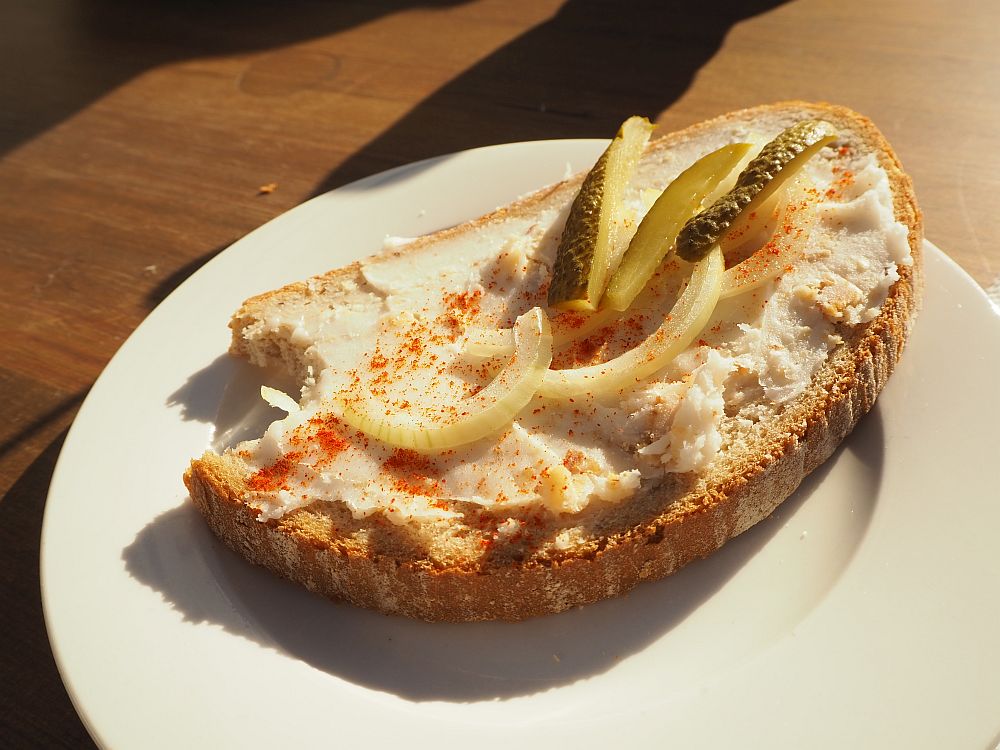
Gardens and Castle at Kroměříž
Note: Since I haven’t visited Kroměříž yet, I asked fellow blogger, Cindy Carlsson of Exploration Vacation, to write it for me.
The charming city of Kroměříž once served as the summer home of the Olomouc archbishops. The chateau and two gardens are designated as a World Heritage site because they form an “exceptionally complete and well-preserved example of a European Baroque princely residence and its gardens.”
Guided tours take visitors through the chateau, which includes much of the decor, furnishings, art, and collections of books and music from when the archbishops lived here. Walking through ornate rooms filled with precious objects, it becomes clear how the upper levels of Catholic clergy came to be called princes of the church. They certainly lived like princes. They even had a throne!

Even if you don’t tour the chateau, make sure to climb the tower for views over the city and surrounding countryside.
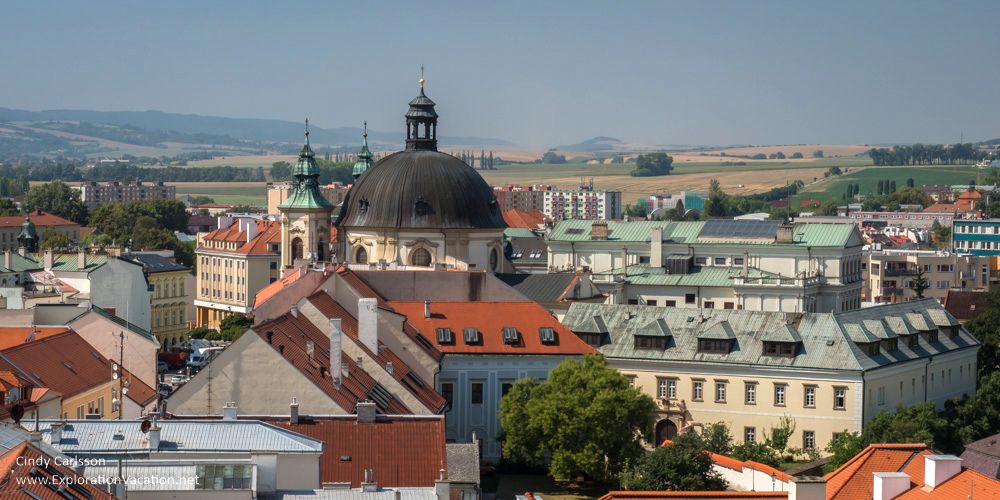
From the chateau visitors can walk directly into a very large garden. The chateau garden is a mix of styles, but largely a landscaped park with open lawns, a collection of trees and shrubs, and a number of garden follies.
However, visitors with limited time should skip the chateau garden and instead visit the nearby Baroque Pleasure Garden.
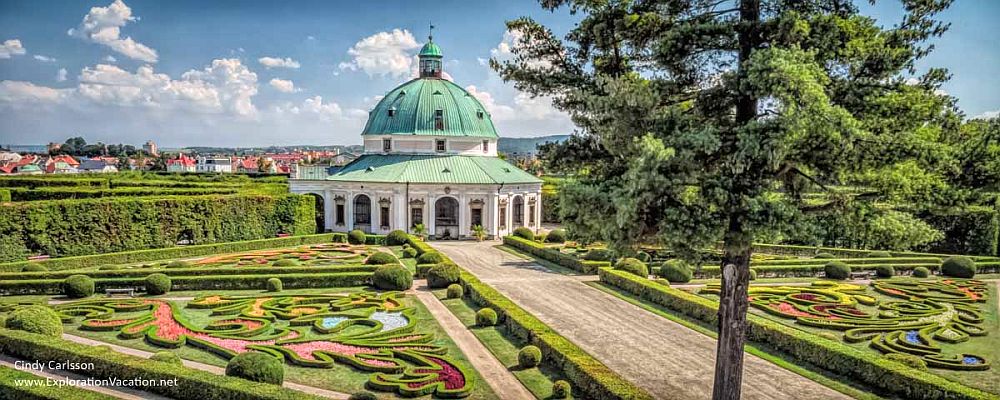
This spectacular small garden was a significant factor in the UNESCO World Heritage designation, as it is a very rare example of an intact Baroque garden. Of course, it is also very beautiful. The Baroque garden is entered through more recent additions, so don’t get too sidetracked along the way. Once you reach it, be sure to climb to the roof of the colonnaded loggia for an overview of the garden’s intricate geometric design.
To read more about the Baroque Flower Garden, check out Cindy’s article: A stroll through the Baroque Flower Garden of Kromeriz Castle.
Kutná Hora
Kutná Hora is probably the most visited of these UNESCO sites in the Czech Republic because it’s so close to Prague: an hour or so by car and two hours by train. The UNESCO site comprises the old town center and two churches: the Church of St Barbara and the Cathedral of Our Lady at Sedlec.
The old town of Kutná Hora has not changed in structure from its medieval roots, and many buildings – including private homes that demonstrate the prosperity that came from the silver-mining industry that flourished here – still show their Gothic or Baroque origins. To read about the two churches and another truly macabre church in Kutná Hora, read my article Kutna Hora UNESCO site and a macabre church.
The Lednice-Valtice Cultural Landscape
Note: I haven’t visited the Lednice-Valtice Cultural Landscape either, so fellow blogger, Cindy Carlsson of Exploration Vacation, wrote this part for me too.
Over the course of 700 years the Liechtenstein family sculpted the landscape of Southern Moravia. In the process, they created what UNESCO describes as one of the largest artificial landscapes in Europe. Covering over 100 square miles, much of the Lednice-Valtice area is basically a very large park around two palaces. Within that park-like area visitors will find a variety of lodges, monuments, carriage lanes, lawns, gardens, ponds, forests, and vineyards. But even with all that, the two impressive palaces will be the highlight for most visitors.
Valtice chateau features an elaborate Baroque exterior, Rococo interior, replica Baroque theater, and historic wine cellar. And, of course, the vast gardens and monument-studded landscaped park lie just beyond the palace gate.
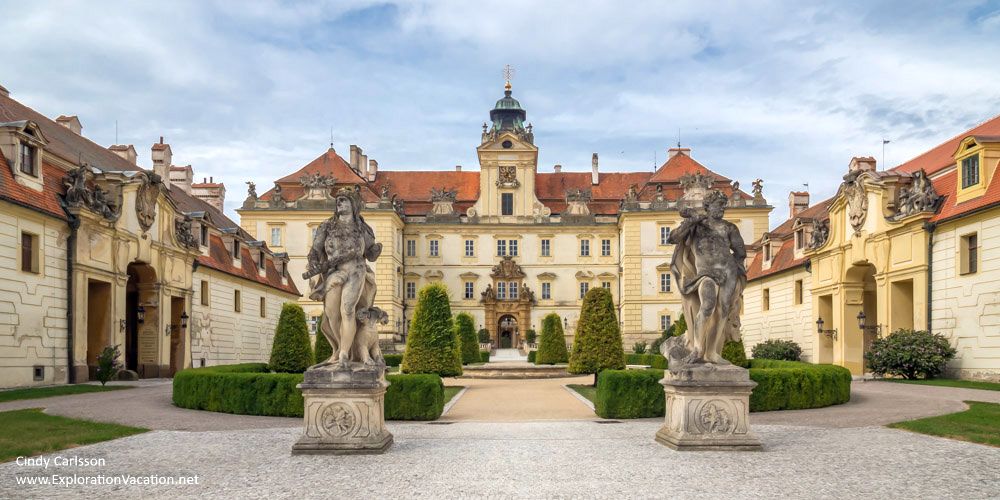
In appearance, Lednice chateau is very different from Valtice. Reconstructed in the 19th century as the family’s summer home, Lednice is Neo-Gothic faux English castle with a tropical conservatory and formal Baroque gardens.
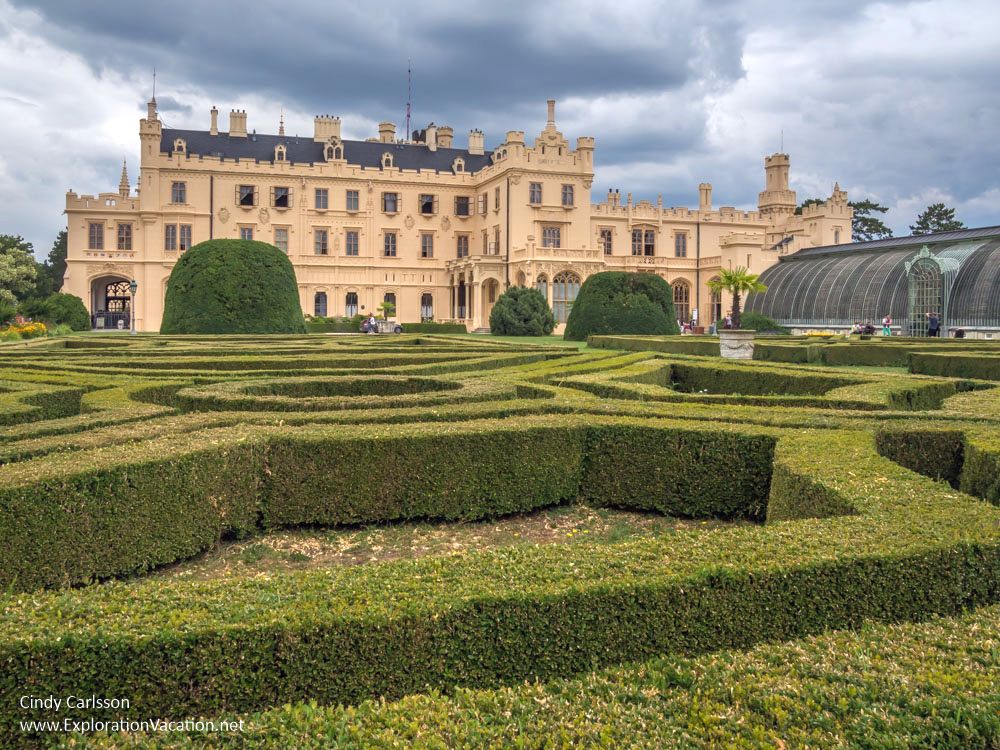
The English Gothic theme is continued inside Lednice chateau, with original decoration and furnishings from the early 20th century. The surrounding gardens feature larger and more elaborate monuments, including a minaret with views over miles of countryside and an impressive faux castle “ruin” that served as a hunting lodge and banquet hall.
I visited on a road trip, but very few sights beyond the palaces are accessible by car. To really experience the Lednice-Valtice Cultural Landscape, slow down and walk or bike the many paths and carriage ways that wind through the area. Carriage rides and boat tours are also available, allowing more visitors to see areas that cannot be reached from the road.
Read more in Cindy’s article, Wander amid Czechia’s beautiful Lednice-Valtice Cultural Landscape.
Litomyšl Castle
Note: This is another one I haven’t visited, so fellow blogger Karen Warren of WorldWideWriter agreed to write this section for me.
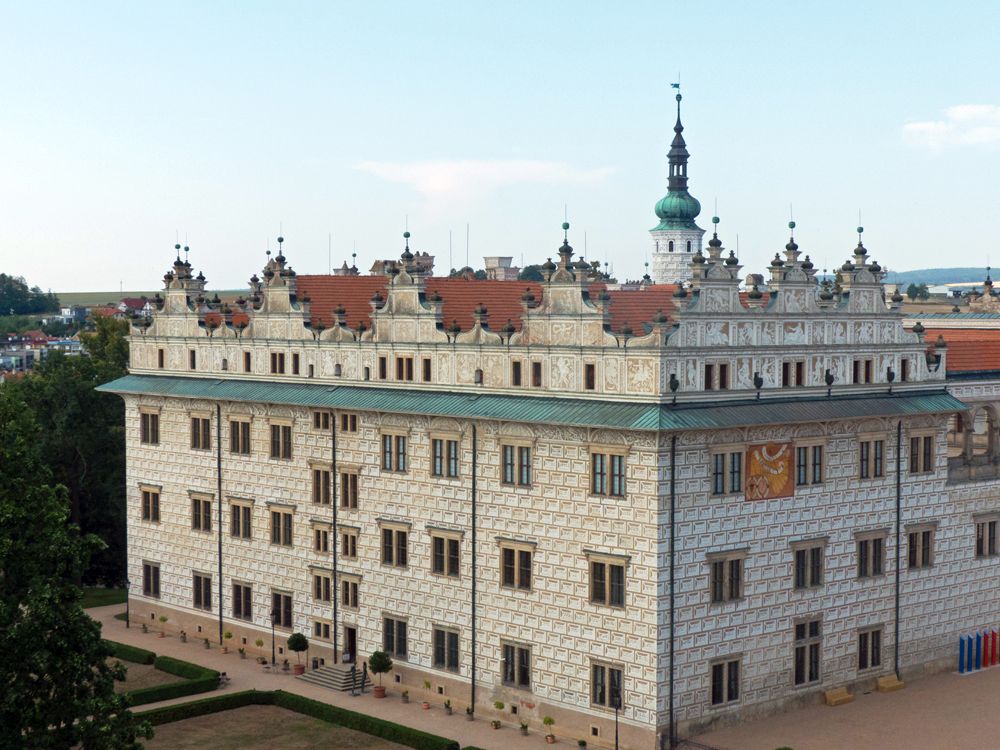
Litomyšl Castle is in the Pardubice region of Eastern Bohemia, around 160 km from Prague. It is one of the largest Renaissance castles in Czechia, and is built in the Italian fashion, with arcades surrounding an open courtyard. The castle became a UNESCO World Heritage Site in 1999, partly because of its impressive architecture, and partly because this style is very unusual in Northern Europe.
A particularly striking feature of Litomyšl Castle is the way the outside has been decorated. Around 8,000 tiny “envelopes”, each of a different design, have been etched into the stone. As well as the envelopes, there are pictures of Biblical and mythological scenes. Although the castle was built in 1568, the classical-style interior is of a later period, and it is furnished in the style of the 18th century.
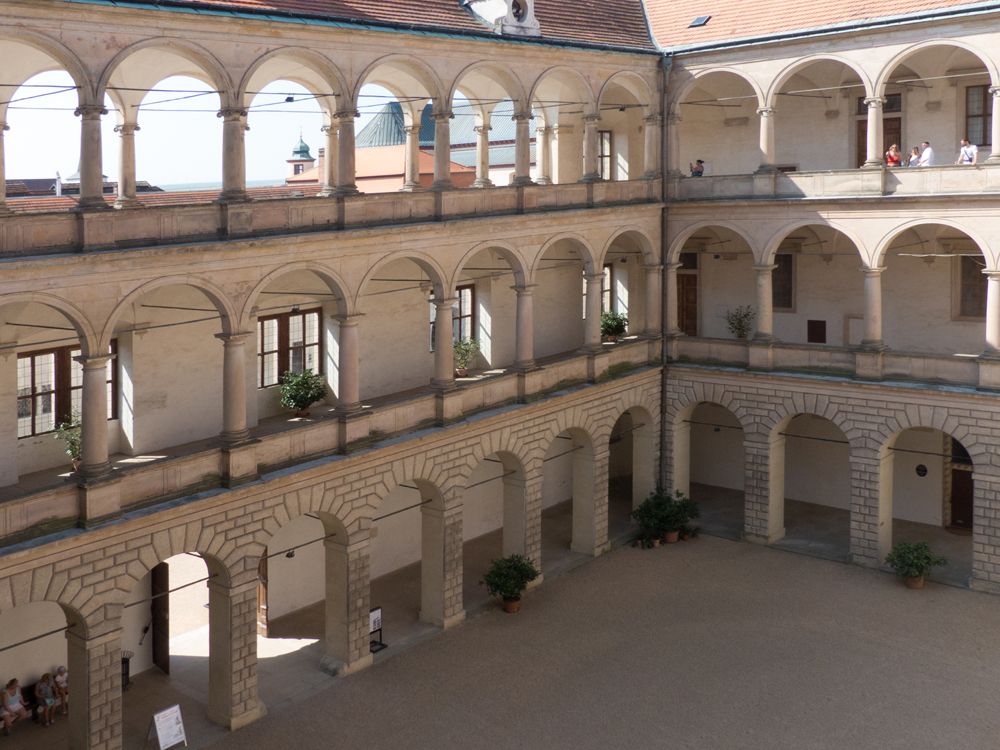
Entrance to the castle is by guided tour (in Czech but with an English transcript). You can also visit the Castle Cellars, where the castle’s own wine label – Chateau Litomyšl – is stored. Or stroll through the Castle Gardens, a parkland area where concerts are performed throughout the year. If you want to extend your visit, you could even stay in the old castle brewery, which has now been converted into rooms for tourists.
To read more about Litomyšl Castle and see more pictures, go to Karen’s more detailed article here.
Olomouc’s UNESCO site
The UNESCO site in Olomouc is really just a single structure: the Holy Trinity Column, which stands in the central town square. You’ll see decorative columns like this in many village and town squares in the region, but this Baroque masterpiece is unique because of its size (32+ meters) and the ornate and skillful sculptures that cover it. Dating to the 18th century, it serves no purpose other than as a statement of faith. Several Moravian artists contributed to it. Unlike most such columns, this one is large enough to have a small chapel inside.
To read more about visiting Olomouc, check out my article A UNESCO site in Olomouc (and other things to see there).
Pilgrimage Church of St John of Nepomuk
This unusual church near Žďár nad Sázavou is UNESCO-listed because of its exceptional architecture. Built in the early 18th century, designed by Jan Blazej Santini, its style, according to the UNESCO site, “falls between neo-Gothic and Baroque”. The church is a tall, blockish building as seen from ground level, but what stands out most is the star-shaped cloister around it.
Notice that both the walls and the church itself are based on a five-pointed star layout. Again, according to UNESCO, this is “a reference to the five stars of the halo of St. John of Nepomuk representing the five virtues of the saint.” I also read in a tourist booklet that it represents Jesus’s “five wounds of martyrdom.”
What you can’t see from either of these pictures is how impressive and imposing this church’s location makes it. It tops a hill with no other nearby buildings.
The Historic Center of Telč
A particular “wow moment” for me was my first sight of Telč’s main square. Lined with lovely rows of pastel-painted houses, the cobblestone square just oozes charm. The houses, built in the Middle Ages but renovated since then, now have Renaissance and Baroque-style facades. Each one is different from the next. An arcade connects them all, allowing shoppers (most of the ground floors are now shops) to stay sheltered.
If you look closely, you’ll see that some of them are covered in sgraffito, which is a style of painting using colored plaster rather than paint. Or they are painted in a trompe l’oeil style.
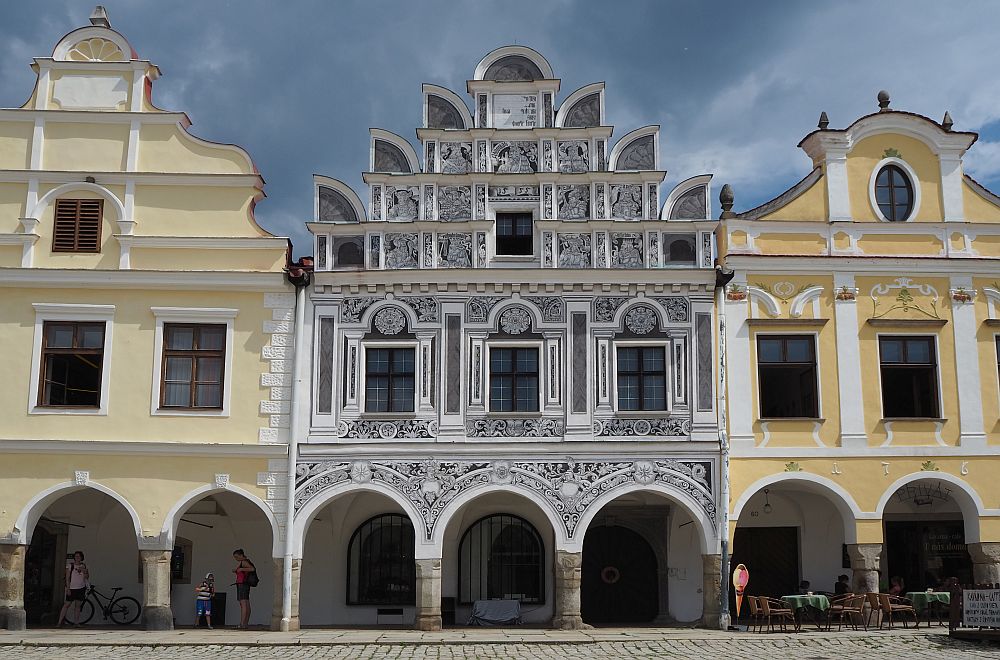
If you go to Telč, make sure to climb the tower of St. James’ Church, at the narrow end of the main square, to get a look at the town from above.
Jewish Quarter and St. Procopius’ Basilica in Třebíč
This Czech UNESCO site includes a former Jewish ghetto, a Jewish cemetery and, oddly, the Catholic Basilica on the hill above it. That is, it seemed odd until I read how UNESCO explains that the sites were combined into one UNESCO listing based on how they represent “an exceptional testimony to the peaceful coexistence of Jewish and Christian communities and cultures from the Middle Ages up to World War II.”
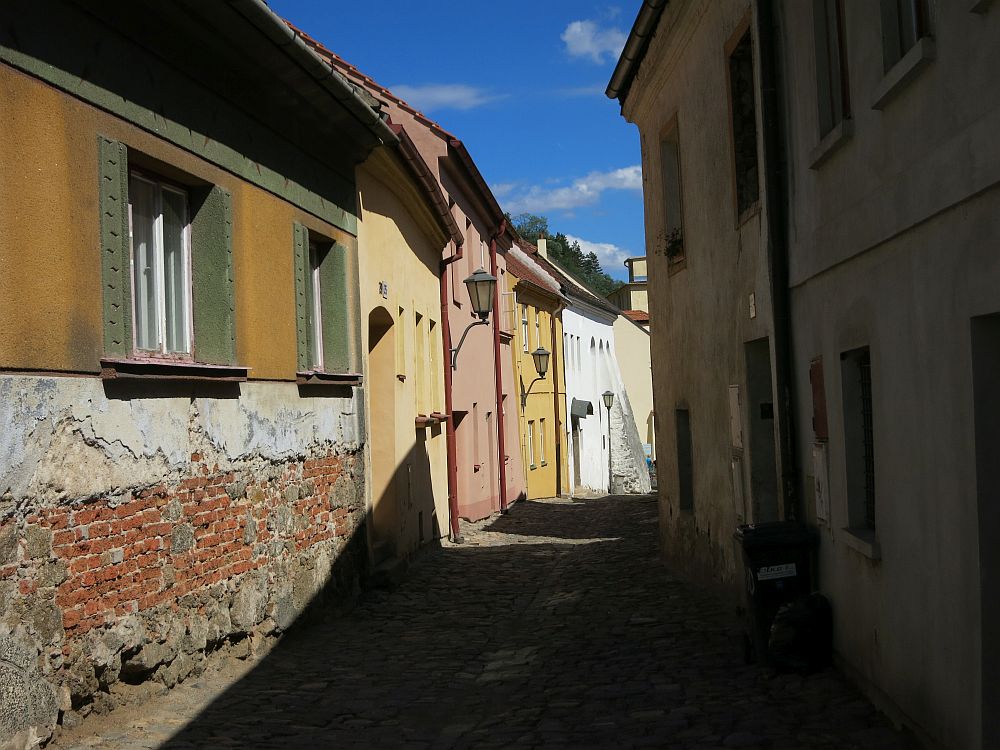
To read more about Třebíč, read Třebíč, Czech Republic: A 3-part UNESCO site.
Villa Tugendhat
I’ve written about Brno before, after an earlier visit. That time, I saw three sites that are not UNESCO sites but that were very interesting, if not a little macabre: an ossuary, a crypt complete with mummies, and a nuclear bomb shelter. But Brno has one UNESCO site, Villa Tugendhat, that I didn’t get to visit until a later trip to Brno.
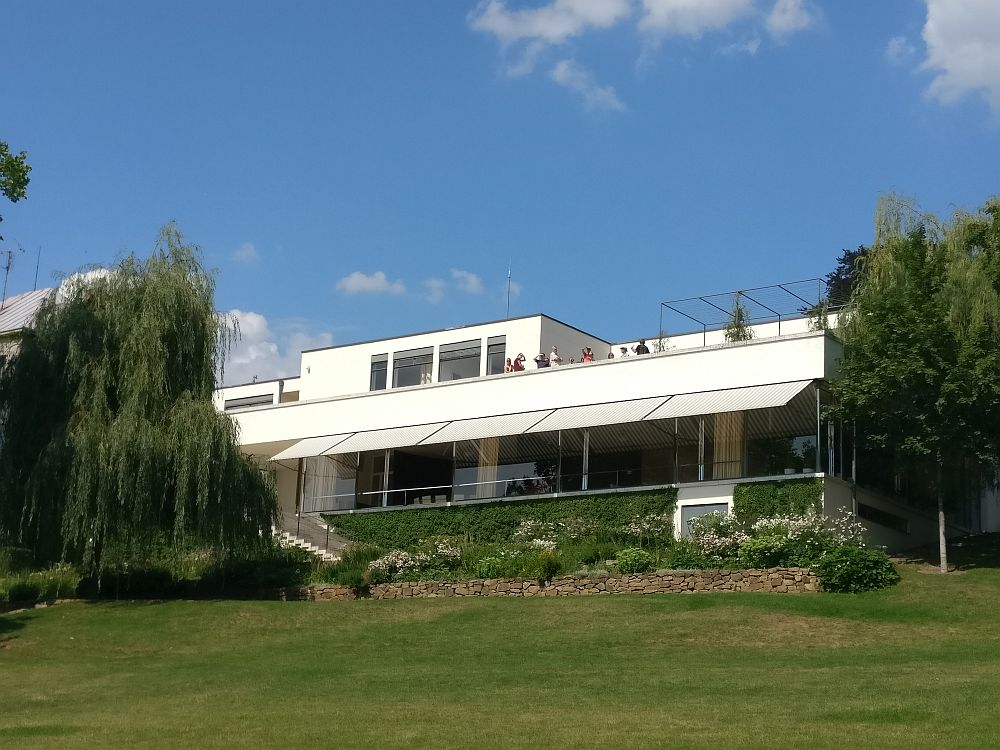
Villa Tugendhat was designed by Mies van der Rohe in 1929-1930, commissioned by Fritz and Greta Tugendhat. Van der Rohe was director of the Bauhaus school in Germany, but his style was not well-liked by the Nazis. Villa Tugendhat was one of van der Rohe’s earliest modern functionalist designs.
The building is unusual in that its iron construction allowed huge plate-glass windows and large open spaces. One wall inside is made of onyx that is, apparently, translucent in some lights.
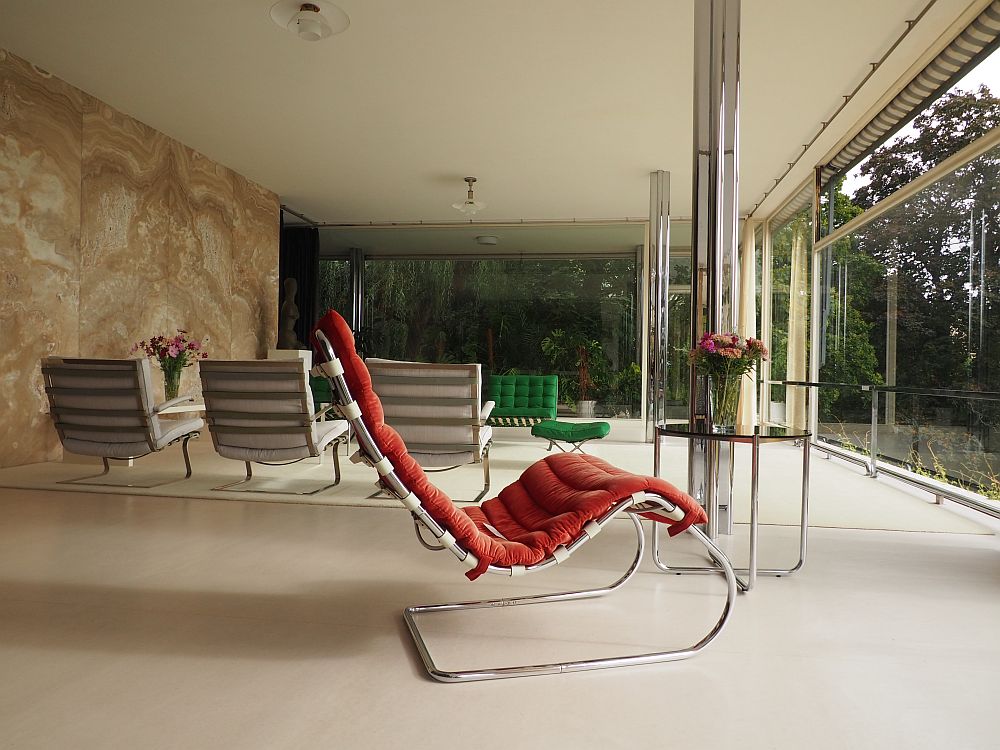
The Tugendhat family, German Jews, only got to live in the villa for a few years, fleeing to Switzerland in 1938. It was used by the Gestapo during the war and was damaged toward the end of the war. Afterwards, the Soviet army took it over. Later it went through a number of other uses. Eventually it was renovated and is now a museum, run by the city of Brno.
Read more about Villa Tugendhat in my separate article.
New UNESCO sites
Two more UNESCO sites have been added to Czechia’s list recently.
The Landscape for Breeding and Training of Ceremonial Carriage Horses is at Kladruby nad Labem in central Czechia. This is a stud farm established by the Hapsburgs, breeding rare Kladruby horses for the last 400+ years. The horses were (and are) used for ceremonial purposes primarily.
Ore Mountain Mining Region is an industrial landscape that straddles the border between Germany and Czechia in the northwest corner of Czechia. It includes a range of museums and industrial buildings – such as mills and smelting works – related to the region’s historical mining industry. Starting in the 12th century, mining of all sorts of raw materials, especially metals like silver, lead, copper and iron, continued into the 20th century.
Touring the UNESCO sites in the Czech Republic
Getting around
The easiest way to see these UNESCO sites in Czechia would be by car, since they’re all quite scattered. Don’t do what I did, though, and try to fit too much in. The driving will always take longer than your GPS predicts, especially if you want to enjoy the scenery at all. The roads are good in Czechia, but twist and turn quite a bit at times. Secondly, all of these places had additional sights worth seeing, especially Cesky Krumlov, Kutná Hora, Olomouc and Telč, and I would have liked more time to see them all well.
Click on the banner below to rent a car:
Book your accommodations by zooming to the location you want on the map below:
It’s easiest, of course, to take a tour. These tours from Prague combine some, but not all, of these UNESCO sites in the Czech Republic.
Visitor information
Český Krumlov: See my article about Český Krumlov for travel information.
Holašovice historic village: Holašovice is about a half-hour’s drive north of Český Krumlov. You can walk around and admire the buildings any time.
Kroměříž Castle: See Cindy Carlsson’s article for travel information.
Kutná Hora: See my article on Kutná Hora for travel information.
Lednice-Valtice Cultural Landscape: Straight south of Brno, the Lednice-Valtice Cultural Landscape is right near the border where the Czech Republic meets Austria and Slovakia. You can take a train to Breclav from Prague, which will take about 3 hours. In Breclav, take another bus to Lednice for about 20 minutes. If you’re driving from Prague, it’ll take under three hours, and from Brno it’s about 45 minutes. Go to this site for Lednice or this site for Valtice to look at the hours of tours. The days and times shift depending on time of year. Prices vary as well.
Litomyšl Castle: Litomyšl Castle is about 2 1/2 hours to the east of Prague, and about halfway between Kutna Hora and Olomouc. Two different tours of the castle are offered from April to October, but with a couple of weeks around Easter when they are closed.
Olomouc: See my separate article about Olomouc for travel information.
Pilgrimage Church of St. John of Nepomuk: If you don’t have a car, you can take a train to Žďár nad Sázavou. From Prague it’ll take about 2½ hours and from Brno about 1¼ hour. You can walk up to the church or take a bus.
Hours: In April and October: Saturday, Sunday and holidays 9:00-17:00. May through September: 9-17:00 daily. The last tour starts at 16:00. The rest of the year, if you are with a group, you might be able to book a tour in advance. The church is only open for guided tours, which take about 45 minutes. Admission: 110 CZK per person (about €4 or $5)
Telč: You can wander the main square of Telc anytime you want. St. James Church tower is open May and September just on Saturday and Sunday 12:00-17:00; in June Tuesday-Saturday 10:00-12:00 and 13:00-17:00 and Sunday 13:00-17:00; in July and August Tuesday-Saturday 10:00-12:00 and 13:00-18:00 and on Sunday 13:00-18:00. The tower may close in bad weather.
Třebíč: See my article on Trebic for travel information.
Villa Tugendhat: Villa Tugendhat is on Černopolní 45 in Brno: an upscale residential neighborhood. It’s a half-hour walk from the train station or you can take tram 9 to Tomanova stop and walk up Tomanova to cut the walking to about 10 minutes.
Hours: Tuesday to Sunday 10:00-18:00. You can only tour the inside with a guided tour, which you should book several months in advance via their website.
Admission: The basic tour (just the first and second floors and the garden) is CZK 300 (€12/$14) and takes about an hour. The extended tour adds the technical room on the ground floor where all the machinery is. It takes an hour and a half and costs CZK 350 (€14/$16). To see only the garden, as I did, costs CZK 50 (€2/$2.50).
And please help me by sharing this post far and wide on social media! Links and pins below!
My travel recommendations
Planning travel
- Skyscanner is where I always start my flight searches.
- Booking.com is the company I use most for finding accommodations. If you prefer, Expedia offers more or less the same.
- Discover Cars offers an easy way to compare prices from all of the major car-rental companies in one place.
- Use Viator or GetYourGuide to find walking tours, day tours, airport pickups, city cards, tickets and whatever else you need at your destination.
- Bookmundi is great when you’re looking for a longer tour of a few days to a few weeks, private or with a group, pretty much anywhere in the world. Lots of different tour companies list their tours here, so you can comparison shop.
- GetTransfer is the place to book your airport-to-hotel transfers (and vice-versa). It’s so reassuring to have this all set up and paid for ahead of time, rather than having to make decisions after a long, tiring flight!
- Buy a GoCity Pass when you’re planning to do a lot of sightseeing on a city trip. It can save you a lot on admissions to museums and other attractions in big cities like New York and Amsterdam.
- It’s really awkward to have to rely on WIFI when you travel overseas. I’ve tried several e-sim cards, and GigSky’s e-sim was the one that was easiest to activate and use. You buy it through their app and activate it when you need it. Use the code RACHEL10 to get a 10% discount!
- Another option I just recently tried for the first time is a portable wifi modem by WifiCandy. It supports up to 8 devices and you just carry it along in your pocket or bag! If you’re traveling with a family or group, it might end up cheaper to use than an e-sim. Use the code RACHELSRUMINATIONS for a 10% discount.
- I’m a fan of SCOTTeVEST’s jackets and vests because when I wear one, I don’t have to carry a handbag. I feel like all my stuff is safer when I travel because it’s in inside pockets close to my body.
- I use ExpressVPN on my phone and laptop when I travel. It keeps me safe from hackers when I use public or hotel wifi.


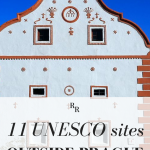
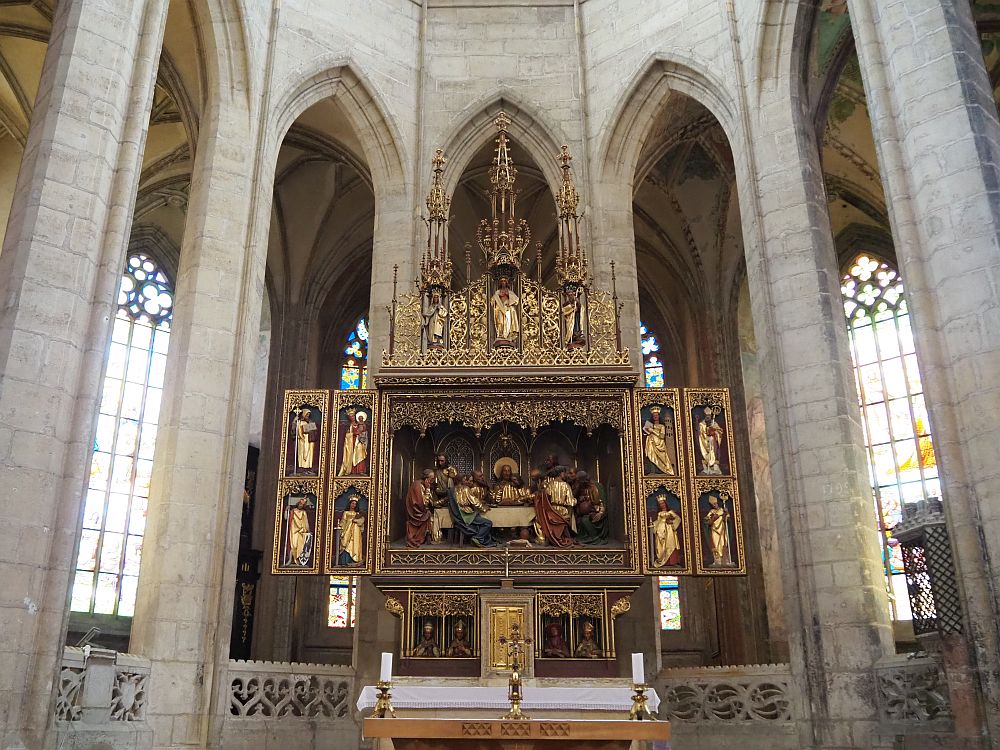
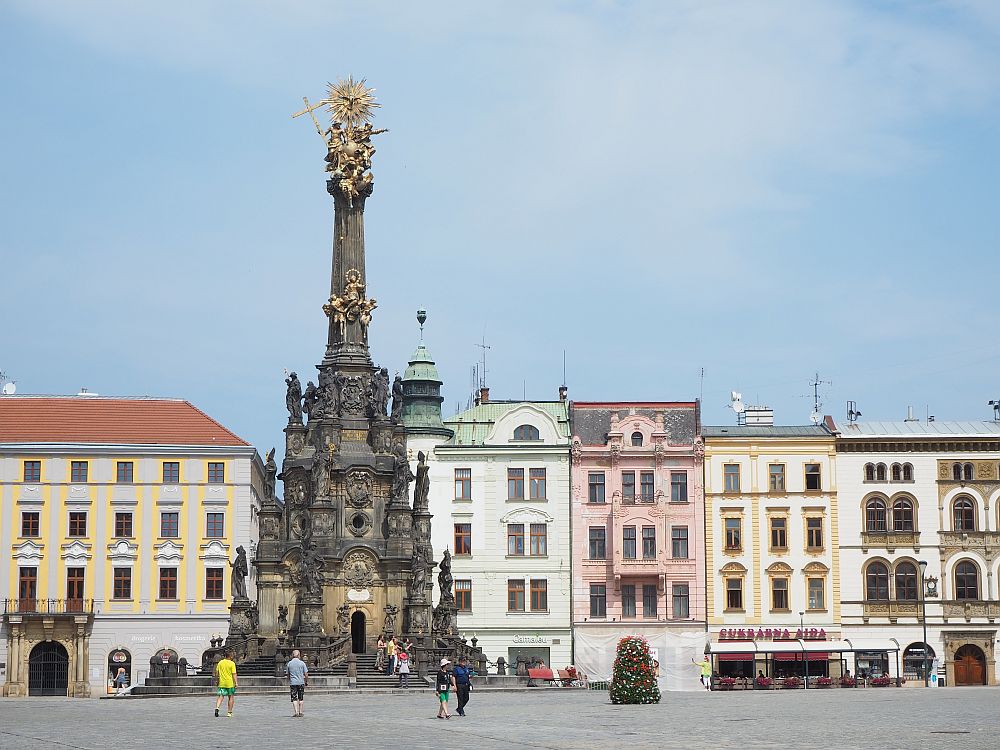
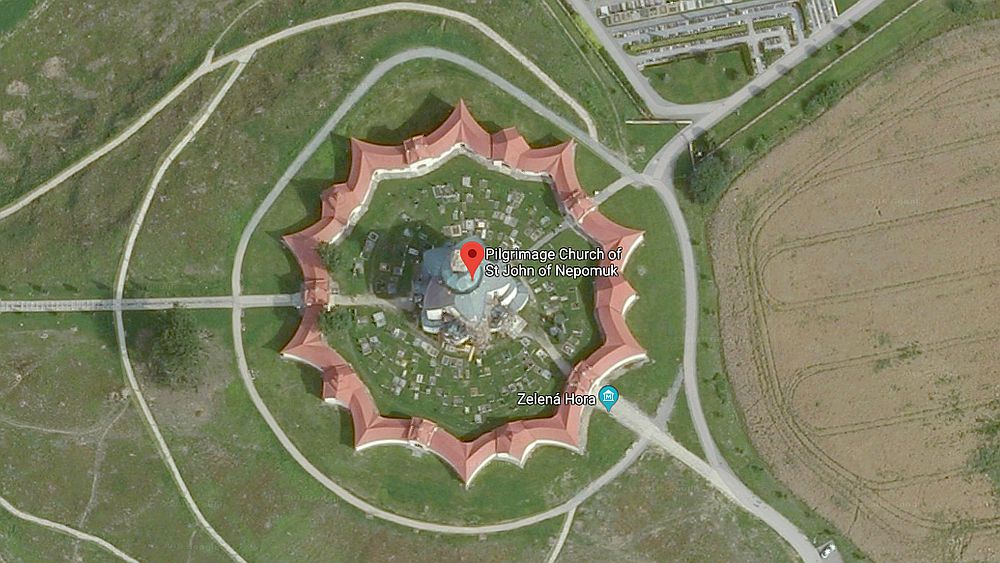
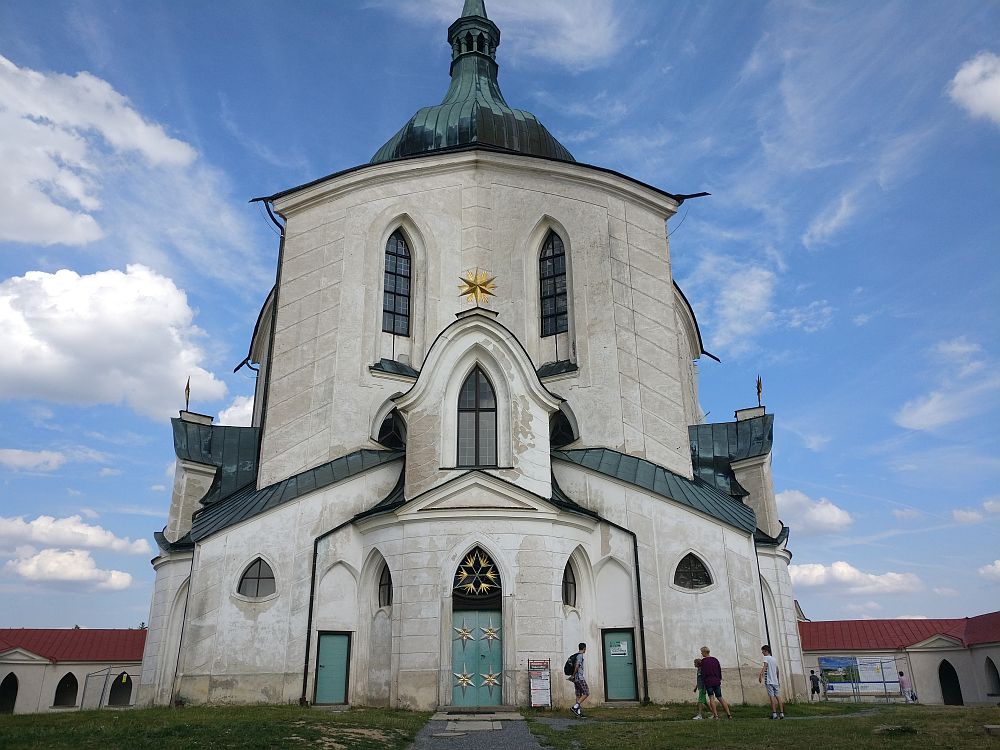
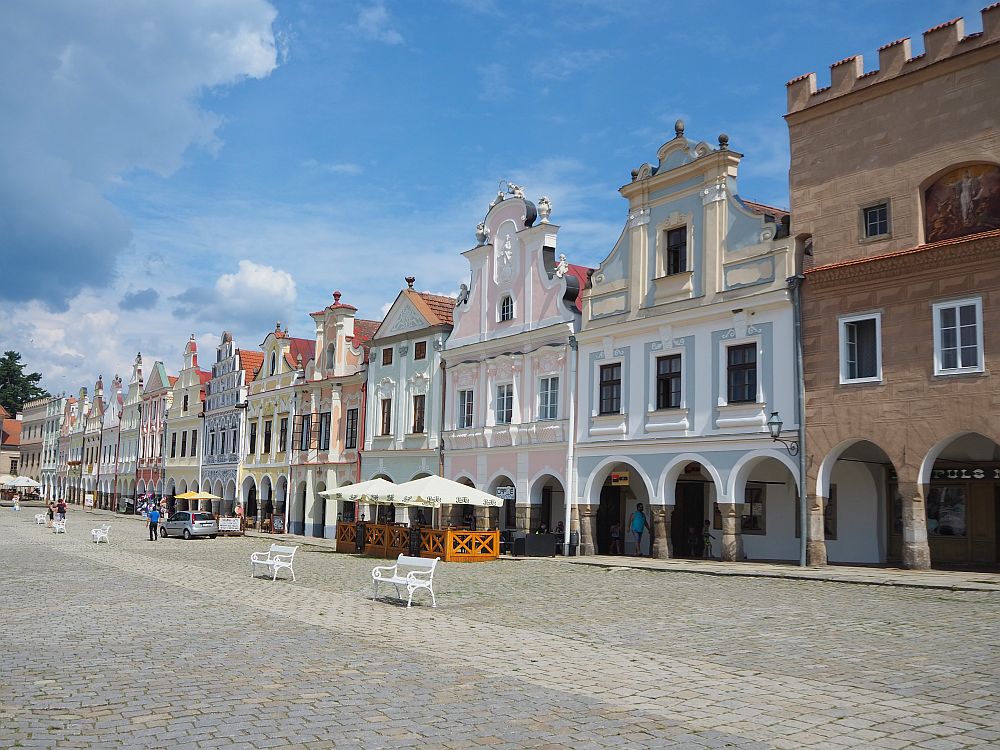
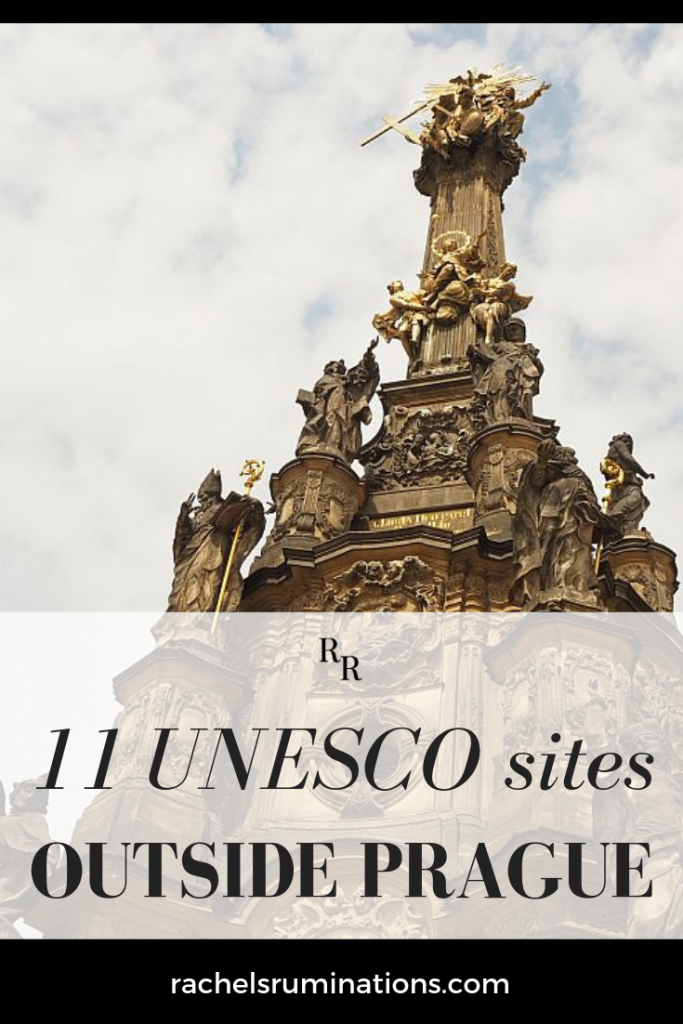

Prague and the whole of CR is seriously on our list. I love central Europe such a lot. Got such a deep soul.
We spent a month in the Czech Republic and did not have time to visit these areas. It is such a beautiful country with so much to see and do. We will have to return to see more.
There’s so much to do in the Czech Republic outside of Prague – I need to go back and see more!
Years ago I had the opportunity to spend 30 days in Prague. i took that time to do day trips by train to several of these sites. I would love to go back one day and see more. It is a great country to explore.
I didn’t realize how much more World Heritage Sites there are outside Prague. I loved your photos of the Holy Trinity Column, the Church of St, John Nepomuck and the lovely decor of the houses in the Main Square of Telc. Your map showed how close I was when I toured Salzburg and Vienna!
What a fascinating post. I loved Prague when we visited in 2014, but sadly didn’t have time to visit anywhere else other than the city. But these UNESCO sites look so interesting and I had no idea that there were so many World Heritage Sites outside of Prague.
Thank you for this reference! Will keep it bookmarked for my next trip.